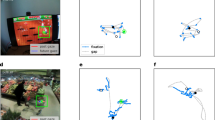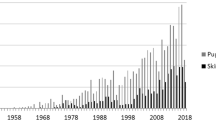Abstract
Steady-state visual evoked potential (SSVEP) has been used to design brain–computer interface (BCI) for a variety of applications, due to its advantages of high accuracy, fewer electrodes, and high information transfer rate. In recent years, researchers developed phase-tagged SSVEP-based BCI to overcome the problem of amplitude–frequency preference in traditional frequency-coded SSVEPs. However, the phase of SSVEP could be affected by subject’s attention and emotion, which sometimes causes ambiguity in discerning gazed targets when fixed phase margins were used for class classification. In this study, we adopted adaptive neuron-fuzzy classifier (ANFC) to improve the gaze-target detections. The SSVEP features in polar coordinates were first transformed into Cartesian coordinates, and then ANFC was utilized to improve the accuracy of gazed-target detections. The proposed ANFC-based approach has achieved 63.07 ± 8.13 bits/min.







Similar content being viewed by others
References
Mason, S.G., Birch, G.E.: A general framework for brain-computer interface design. IEEE Trans. Neural Syst. Rehabil Eng. 11(1), 70–85 (2003)
Hinterberger, T., Weiskopf, N., Veit, R., Wilhelm, B., Betta, E., Birbaumer, N.: An EEG-driven brain-computer interface combined with functional magnetic resonance imaging (fMRI). IEEE Trans. Biomed. Eng. 51(6), 971–974 (2004)
Georgopoulos, A.P., Langheim, F.J., Leuthold, A.C., Merkle, A.N.: Magnetoencephalographic signals predict movement trajectory in space. Exp. Brain Res. 167(1), 132–135 (2005)
Curran, E.A., Stokes, M.J.: Learning to control brain activity: a review of the production and control of EEG components for driving brain–computer interface (BCI) systems. Brain Cogn. 51(3), 326–336 (2003)
Weiskopf, N., Mathiak, K., Bock, S.W., Scharnowski, F., Veit, R., Grodd, W., Goebel, R., Birbaumer, N.: Principles of a brain-computer interface (BCI) based on real-time functional magnetic resonance imaging (fMRI). IEEE Trans. Biomed. Eng. 51(6), 966–970 (2004)
Chen, C.-H., Ho, M.-S., Shyu, K.-K., Hsu, K.-C., Wang, K.-W., Lee, P.-L.: A noninvasive brain computer interface using visually-induced near-infrared spectroscopy responses. Neurosci. Lett. 580, 22–26 (2014)
Birbaumer, N., Ghanayim, N., Hinterberger, T., Iversen, I., Kotchoubey, B., Kübler, A., Perelmouter, J., Taub, E., Flor, H.: A spelling device for the paralysed. Nature 398(6725), 297–298 (1999)
Donchin, E., Spencer, K.M., Wijesinghe, R.: The mental prosthesis: assessing the speed of a P300-based brain-computer interface. IEEE Trans. Rehabil. Eng. 8(2), 174–179 (2000)
Lee, P.-L., Hsieh, J.-C., Wu, C.-H., Shyu, K.-K., Wu, Y.-T.: Brain computer interface using flash onset and offset visual evoked potentials. Clin. Neurophysiol. 119(3), 605–616 (2008)
Huang, D., Qian, K., Fei, D.-Y., Jia, W., Chen, X., Bai, O.: Electroencephalography (EEG)-based brain–computer interface (BCI): A 2-D virtual wheelchair control based on event-related desynchronization/synchronization and state control. IEEE Trans. Neural Syst. Rehabil. Eng. 20(3), 379–388 (2012)
Müller-Putz, G.R., Pfurtscheller, G.: Control of an electrical prosthesis with an SSVEP-based BCI. IEEE Trans. Biomed. Eng. 55(1), 361–364 (2008)
Ortner, R., Allison, B.Z., Korisek, G., Gaggl, H., Pfurtscheller, G.: An SSVEP BCI to control a hand orthosis for persons with tetraplegia. IEEE Trans. Neural Syst. Rehabil. Eng. 19(1), 1–5 (2011)
Martinez, P., Bakardjian, H., Cichocki, A.: Fully online multicommand brain-computer interface with visual neurofeedback using SSVEP paradigm. Comput. Intell. Neurosci. 2007, 13 (2007)
Hsu, H.-T., Lee, I.-H., Tsai, H.-T., Chang, H.-C., Shyu, K.-K., Hsu, C.-C., Chang, H.-H., Yeh, T.-K., Chang, C.-Y., Lee, P.-L.: Evaluate the feasibility of using frontal SSVEP to implement an SSVEP-based BCI in young, Elderly and ALS Groups. IEEE Trans. Neural Syst. Rehabil. Eng. 24(5), 603–615 (2016)
Lin, Z., Zhang, C., Wu, W., Gao, X.: Frequency recognition based on canonical correlation analysis for SSVEP-based BCIs. IEEE Trans. Biomed. Eng. 53(12), 2610–2614 (2006)
Zhang, Y., Dong, L., Zhang, R., Yao, D., Zhang, Y., Xu, P.: An efficient frequency recognition method based on likelihood ratio test for SSVEP-based BCI. Comput. Math. Methods Med. (2014). doi:10.1155/2014/908719
Zhang, Y., Jin, J., Qing, X., Wang, B., Wang, X.: LASSO based stimulus frequency recognition model for SSVEP BCIs. Biomed. Signal Process. Control 7(2), 104–111 (2012)
Lee, P.-L., Sie, J.-J., Liu, Y.-J., Wu, C.-H., Lee, M.-H., Shu, C.-H., Li, P.-H., Sun, C.-W., Shyu, K.-K.: An SSVEP-actuated brain computer interface using phase-tagged flickering sequences: a cursor system. Ann. Biomed. Eng. 38(7), 2383–2397 (2010)
Shyu, K.-K., Lee, P.-L., Lee, M.-H., Lin, M.-H., Lai, R.-J., Chiu, Y.-J.: Development of a low-cost FPGA-based SSVEP BCI multimedia control system. IEEE Trans.Biomed. Circ. Syst. 4(2), 125–132 (2010)
Jia, C., Gao, X., Hong, B., Gao, S.: Frequency and phase mixed coding in SSVEP-based brain–computer interface. IEEE Trans. Biomed. Eng. 58(1), 200–206 (2011)
Zhu, D., Molina, G. G., Mihajlović, V., Aarts, R. M.: Phase synchrony analysis for SSVEP-based BCIs. In: 2010 2nd International Conference on Computer Engineering and Technology (ICCET) IEEE (2010)
Morgan, S., Hansen, J., Hillyard, S.: Selective attention to stimulus location modulates the steady-state visual evoked potential. Proc. Natl. Acad. Sci. 93(10), 4770–4774 (1996)
Silberstein, R.B., Pipingas, A.: Steady-state visually evoked potential topography during the Wisconsin card sorting test. Electroencephalogr. Clin. Neurophysiol. 96(1), 24–35 (1995)
Thompson, J.C., Tzambazis, K., Stough, C., Nagata, K., Silberstein, R.B.: The effects of nicotine on the 13 Hz steady-state visually evoked potential. Clin. Neurophysiol. 111(9), 1589–1595 (2000)
Bakardjian, H., Tanaka, T., Cichocki, A.: Emotional faces boost up steady-state visual responsesforbrain–computer interface. NeuroReport 22(3), 121–125 (2011)
Silberstein, R.B., Nunez, P.L., Pipingas, A., Harris, P., Danieli, F.: Steady state visually evoked potential (SSVEP) topography in a graded working memory task. Int. J. Psychophysiol. 42(2), 219–232 (2001)
Gray, M., Kemp, A., Silberstein, R., Nathan, P.: Cortical neurophysiology of anticipatory anxiety: an investigation utilizing steady state probe topography (SSPT). Neuroimage 20(2), 975–986 (2003)
Falzon, O., Camilleri, K., Muscat, J.: Complex-valued spatial filters for SSVEP-based BCIs with phase coding. IEEE Trans. Biomed. Eng. 59(9), 2486–2495 (2012)
Kayikcioglu, T., Aydemir, O.: A polynomial fitting and k-NN based approach for improving classification of motor imagery BCI data. Pattern Recogn. Lett. 31(11), 1207–1215 (2010)
Pfurtscheller, G., Kalcher, J., Neuper, C., Flotzinger, D., Pregenzer, M.: On-line EEG classification during externally-paced hand movements using a neural network-based classifier. Electroencephalogr. Clin. Neurophysiol. 99(5), 416–425 (1996)
Lotte, F.: The use of fuzzy inference systems for classification in EEG-based brain-computer interfaces. In: 3rd International Brain–Computer Interfaces Workshop and Training Course (2006)
Güler, I., Übeyli, E.D.: Adaptive neuro-fuzzy inference system for classification of EEG signals using wavelet coefficients. J. Neurosci. Methods 148(2), 113–121 (2005)
Hsu, W.-Y.: Motor imagery electroencephalogram analysis using adaptive neural-fuzzy classification. Int. J. Fuzzy Syst. 16, 111–120 (2014)
Begum, D., Ravikumar, K., Mathew, J., Kubakaddi, S., Yadav, R.: EEG based patient monitoring system for mental alertness using adaptive Neuro-Fuzzy approach. J. Med. Bioeng. 4(1) (2015)
Bhattacharyya, S., Basu, D., Konar, A., Tibarewala, D.: Interval type-2 fuzzy logic based multiclass ANFIS algorithm for real-time EEG based movement control of a robot arm. Robot. Auton. Syst. 68, 104–115 (2015)
Misulis, K.E.: Spehlmann’s evoked potential primer: visual, auditory, and somatosensory evoked potentials in clinical diagnosis. Butterworth-Heinemann Medical, Oxford (1994)
Alpaydin, E.: Introduction to Machine Learning. MIT press, Cambridge (2014)
Møller, M.F.: A scaled conjugate gradient algorithm for fast supervised learning. Neural Netw. 6(4), 525–533 (1993)
Chang, H.-C., Lee, P.-L., Lo, M.-T., Lee, I., Yeh, T.-K., Chang, C.-Y.: Independence of amplitude-frequency and phase calibrations in an SSVEP-based BCI using stepping delay flickering sequences. IEEE Trans. Neural Syst. Rehabil. Eng. 20(3), 305–312 (2012)
Kelly, S.P., Lalor, E.C., Reilly, R.B., Foxe, J.J.: Visual spatial attention tracking using high-density SSVEP data for independent brain-computer communication. IEEE Trans. Neural Syst. Rehabil. Eng. 13(2), 172–178 (2005)
Asadpour, V., Ravanfar, M. R., Fazel-Rezai, R.: Adaptive network fuzzy inference systems for classification in a brain computer interface. In: Fazel-Rezai, F. (ed.) Brain-Computer Interface Systems - Recent Progress and Future Prospects. Intex (2013). doi:10.5772/55989
Wu, H.-Y., Lee, P.-L., Chang, H.-C., Hsieh, J.-C.: Accounting for phase drifts in SSVEP-based BCIs by means of biphasic stimulation. IEEE Trans. Biomed. Eng. 58(5), 1394–1402 (2011)
Acknowledgments
This study was funded by the National Central University, Ministry of Science and Technology (104-3115-E-008-001, 103-2511-S-008-003-MY2, 103- 2217-E-008-001, 103-2218-E-008-006, 102-2221-E- 008-086-MY3), Taipei Medical University Project (101TMUH-NCU-001, TMU102-AE1-B09).
Author information
Authors and Affiliations
Corresponding author
Rights and permissions
About this article
Cite this article
Hsu, HT., Lee, PL. & Shyu, KK. Improvement of Classification Accuracy in a Phase-Tagged Steady-State Visual Evoked Potential-Based Brain–Computer Interface Using Adaptive Neuron-Fuzzy Classifier. Int. J. Fuzzy Syst. 19, 542–552 (2017). https://doi.org/10.1007/s40815-016-0248-z
Received:
Revised:
Accepted:
Published:
Issue Date:
DOI: https://doi.org/10.1007/s40815-016-0248-z




